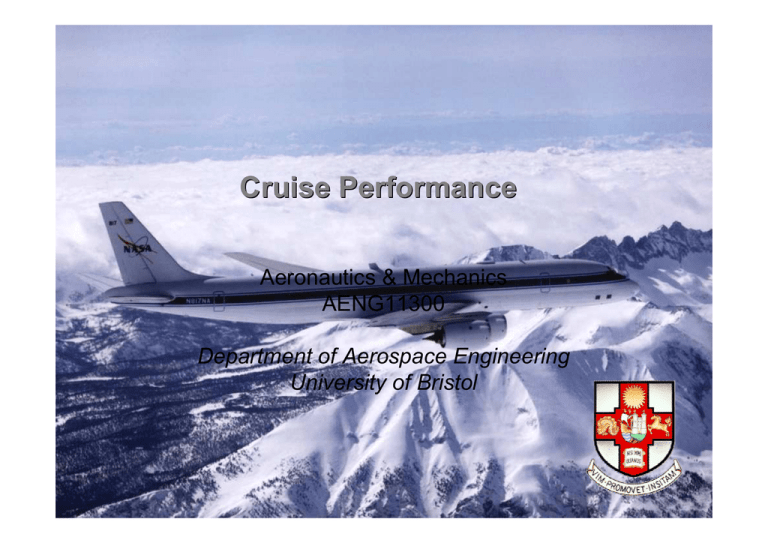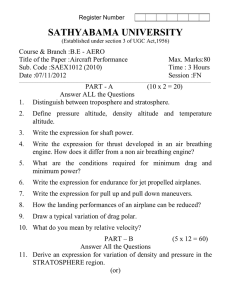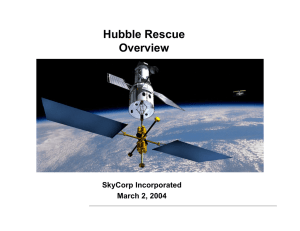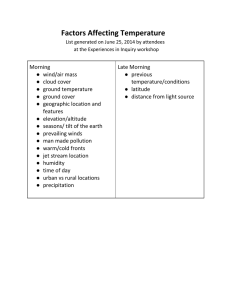Cruise Performance - University of Southampton
advertisement

Cruise Performance Aeronautics & Mechanics AENG11300 Department of Aerospace Engineering University of Bristol Introduction to Aeronautics (04/05) : Slide 5.1 Engine Characteristics two main classes of engines: 1. ‘constant-power’ engines where shaft horsepower output is roughly constant with speed – piston engines & turboprops – ie propeller-driven 2. ‘constant-thrust’ engines where thrust output is roughly constant with speed – turbojets & turbofans – ie jet-driven a gross simplification – but useful for preliminary performance work all produce thrust by imparting an increase in velocity to the air passing through the engine Introduction to Aeronautics (04/05) : Slide 5.2 Thrust Generation basic thrust equation – Newton’s 2nd Law → force = rate of change of momentum T = m& (V j − V ) Vj = jet efflux velocity fuel consumption related to power ‘wasted’ in the jet P lost = .m = mass flow rate (kg/s) 1 2 2 m& (V j − V ) propeller = high mass flow but low ‘jet’ velocity Vj – low fuel consumption – rapid loss of thrust with forward speed jet = low mass flow but high jet velocity Vj – high fuel consumption – little loss of thrust with forward speed Introduction to Aeronautics (04/05) : Slide 5.3 Turbojet and Turbofan Engines Turbojet low pressure compressor high pressure compressor combustion chamber turbine nozzle Turbofan fan Introduction to Aeronautics (04/05) : Slide 5.4 Turbojet and Turbofan Engines Introduction to Aeronautics (04/05) : Slide 5.5 Turbojet vs Turboprop Engines characteristics determined by the bypass ratio (BPR) – ratio of air passing through fan (or propeller) to air passing through engine core fuel consumption thrust BPR BPR speed limit on propeller Introduction to Aeronautics (04/05) : Slide 5.6 Propeller Efficiency propeller acts as rotating wing – ‘direction of flight’ determined by advance ratio J = V/nD – where n is RPM and D is propeller diameter local angle of attack governed by advance ratio and blade pitch angle setting – blade twist (washout) needed efficiency η peaks in narrow speed range – effect of stall η fine coarse use variable-pitch prop – fine pitch at low speed – coarse pitch at high speed Introduction to Aeronautics (04/05) : Slide 5.7 J Basic Cruise Performance Introduction to Aeronautics (04/05) : Slide 5.8 Hunter flypast Jet Aircraft in Cruise 60 drag, thrust increasing weight thrust at sea level 40 3km 6km 9km ceiling = 11km 20 12km stall boundary 0 0 50 VMD 100 150 200 250 VE = V√σ Introduction to Aeronautics (04/05) : Slide 5.9 Features of Jet Cruise Diagram simplified representation of thrust T = kT0σ 0.7 – throttle setting k – thrust at sea level T0 (independent of speed) – density ratio σ (to power 0.7 below 11km, to power 1.0 above) maximum and minimum speed at each altitude for T = D – lower speed may be unattainable at low altitude due to stall – upper speed is practical cruise speed – between upper and lower speed aircraft will accelerate or climb unless throttle setting is reduced at one particular height there is just sufficient height to cruise at one speed only – this is the absolute ceiling for the throttle setting used – achieved at minimum drag speed increasing weight reduces cruise speed and lowers ceiling Introduction to Aeronautics (04/05) : Slide 5.10 Jet Aircraft Cruise Speed 12 absolute ceiling altitude (km) 10 stall boundary 8 VMAX VEAS 6 VTAS 4 2 0 0 50 100 150 200 VEAS , VTAS Introduction to Aeronautics (04/05) : Slide 5.11 250 Features of Jet Cruise Speed cruise speed in EAS reduces steadily as altitude increases maximum cruise speed in TAS increases with altitude – up to a maximum Vmax before the absolute ceiling is reached demonstrates some advantages of cruise at high altitude – maximum cruise speed in TAS (ie ground speed) similar to (or greater than) speed at sea level – thrust at maximum cruise speed reduces with altitude → fuel consumption reduces with altitude minimum fuel consumption at minimum drag speed – work done = thrust × distance – in theory should be unaffected by altitude (since Dmin constant), but 1. at low altitudes engine would need to be throttled back → reduced thermodynamic efficiency & hence increased fuel burn 2. cruise speed in TAS for minimum drag increases with altitude Introduction to Aeronautics (04/05) : Slide 5.12 Speed Stability in Cruise consider aircraft with throttle adjusted to cruise at points 1, 2 and 3 – what is effect of small fluctuations in velocity (eg due to gusts) ?? 20 1. speed increase T,D = increase in drag 1 T1 – aircraft decelerates = stable 15 2. speed increase 2 T2 = reduction in drag 10 3 T3 – aircraft accelerates = unstable 3. speed increase 5 = no change in drag – aircraft is neutrally stable 0 0 50 in case 2 pilot must continually adjust throttle to maintain speed 100 – flight on ‘backside of drag curve’ – rather unsafe! Introduction to Aeronautics (04/05) : Slide 5.13 150 VE 200 Speed Stability at Ceiling absolute ceiling is an unstable condition to maintain – maximum thrust setting at minimum drag speed → any change in speed will increase drag above available thrust and hence cause aircraft to descend excess thrust and hence rate of climb drop to zero as ceiling is approached – absolute ceiling cannot be established in reasonable time! service ceiling is a practical alternative definition of maximum operating altitude – at the service ceiling the aircraft still has a small specified rate of climb – defined as 2.5 m/s for jet aircraft and 0.5 m/s for propellerdriven aircraft Introduction to Aeronautics (04/05) : Slide 5.14 Propeller-Driven Aircraft in Cruise 12000 P√σ power at sea level 8000 3km increasing weight 6km 4000 9km 12km 0 stall boundary 0 50 ceiling = 12.5km VMP 100 150 200 250 VE = V√σ Introduction to Aeronautics (04/05) : Slide 5.15 Range and Endurance – Jet Aircraft Introduction to Aeronautics (04/05) : Slide 5.16 Proteus Range and Endurance endurance - the time an aircraft can remain in flight – important for surveillance type missions range – the horizontal distance that an aircraft can cover: 1. Safe Range – the maximum distance between two airfields for which an aircraft can fly a safe and reliably regular service with a specified payload – rather lengthy calculation of full mission profile (take-off/climb/ cruise/descent/landing, headwinds, diversion allowance etc) – therefore simplified measures of range used in project work … 2. Still Air Range (SAR) – take-off with full fuel, climb to cruise altitude, cruise until all fuel expended (!) 3. Gross Still Air Range (GSAR) – begin at selected altitude with full fuel, cruise until all fuel has gone – approximate factor between GSAR and Safe Range known Introduction to Aeronautics (04/05) : Slide 5.17 Breguet Range Equation – Jet Aircraft actually derived by Coffin in the 1920’s – compact and simple way of calculating GSAR “rate at which fuel is burnt = rate at which aircraft weight is reduced” define thrust specific fuel consumption (sfc or TSFC) as – f = mass of fuel burnt per unit of thrust per second – consistent units are kg/N.s – but often given in terms of kg/N.hr so don’t forget to convert! for thrust T and weight W the basic Breguet equation is dW = − fg T dt – a differential equation (in units of N/s ) Introduction to Aeronautics (04/05) : Slide 5.18 Integration of Breguet Equation - Endurance rearranging and substituting T = D and W = L dW dt = − fgT CD D W T= W= CL L 1 C L dW dt = − fg C D W assume that CL/CD and f remain constant can then integrate from start weight W1 to end weight W2 to obtain the endurance E dx ∫ x = ln x E = t 2 − t1 = t12 Introduction to Aeronautics (04/05) : Slide 5.19 1 C L W1 ln = fg C D W2 Integration of Breguet Equation - Range increment in distance dS at velocity V is given by V C L dW dS = Vdt = − fg C D W assume that true air speed V remains constant can then integrate from start weight W1 to end weight W2 to obtain the range R V C L W1 R = S 2 − S1 = ln fg C D W2 Introduction to Aeronautics (04/05) : Slide 5.20 Implications of Assumptions (1) is it justifiable to assume CL/CD , f and VTAS to be constant? – only in particular circumstances… as fuel is burnt weight W and hence required lift L reduces if VTAS held constant then either CL and/or σ must reduce constant CL/CD → constant CL (= constant incidence α) → therefore σ must decrease ≡ altitude must increase constant CL/CD implies constant CD → therefore drag D decreases in proportion to σ since T = D, thrust must also decrease with altitude while constant sfc f implies constant throttle setting → approximately true for turbojet in stratosphere (above ~ 11km), where T ≈ kT σ 0 Introduction to Aeronautics (04/05) : Slide 5.21 L = W = 12 ρ 0σV 2 SC L Cruise-Climb this cruise case often referred to as a cruise-climb – usually precluded by air traffic control restrictions! note that below 11km (in the troposphere) temperature falls with altitude → thrust falls off less rapidly → need to back-off on throttle to maintain V and CL constant, hence sfc would worsen maximise cruise speed – ie cruise at high altitude V C L W1 ln R = fg C D W2 a measure of thermodynamic efficiency – ie minimise fuel consumption f a measure of aerodynamic efficiency – ie minimise drag D Introduction to Aeronautics (04/05) : Slide 5.22 a measure of structural efficiency – ie minimise fixed weight W2 Constant Altitude Cruise as before V C L dW dS = Vdt = − fg C D W but now assume σ and hence ρ are constant, but V varies substitute velocity equation V = W 1 2 ρSC L 1 dS = − fg 2 C L1 2 dW ρS C D W 1 2 and integrate dx 12 = 2x ∫ x1 2 R = S 2 − S1 = Introduction to Aeronautics (04/05) : Slide 5.23 8 1 C L1 2 1 2 W1 − W21 2 ρS fg C D ( ) Implications of Assumptions (2) height (hence density ρ) and CL held constant as fuel is burnt weight W and hence required lift L reduces → VTAS must also reduce → range is less than for cruise-climb for same CL /CD since CD is constant, drag D and hence thrust T also reduce → therefore throttle setting must be reduced progressively during the cruise → therefore some variation in sfc f will occur need to use average value of f, or treat as a series of shorter steps – if each step flown at an increased height an approximation to a cruise-climb profile can be obtained Introduction to Aeronautics (04/05) : Slide 5.24 Maximum Range – Cruise-Climb (1) maximum range depends on variation of thrust with height R = 1 fg C L W1 V ln C D W2 start with basic T = T0σ with fixed throttle → sfc f and velocity V constant – but altitude (and hence σ ) undefined for maximum range we require V(CL/CD) to be a maximum use the thrust/drag relation to eliminate σ T0 T = T0σ = D = C D 12 ρ 0σV 2 S V = 1 2 ρ 0 SC D and hence V CL = CD Introduction to Aeronautics (04/05) : Slide 5.25 2T0 C L ρ 0 S C D3 2 → therefore need to find minimum CD3/2 /CL Maximum Range – Cruise-Climb (2) ( C C D 0 + KC = CL CL 32 D ( ) 32 D d C CL dC L ) = C 3 L 2 (C D0 + KC 2 C = 2 KC so at the minimum point D 0 L CD max R u vdu − udv d = v2 v 2 32 L 3 = CD0 , CL = max R 2 cruise conditions fixed by thrust – CL and CD obtained from above CL = → substitute with T0 into V CD ) 2 12 L CD0 2K 2T0 C L ρ 0 S C D3 2 – then substitute into Breguet Equation to find range Introduction to Aeronautics (04/05) : Slide 5.26 ( 2 KC L − C D 0 + KC C L2 ) 2 32 L cruise-climb with T = T0σ Maximum Range – Cruise-Climb (3) alternatively specify start altitude (and hence σ1) and let thrust vary as required 1 C L W1 ln V → sfc f and velocity V constant R = fg C D W2 for maximum range we still require V(CL/CD) to be a maximum since σ is not a variable, we can simply substitute the speed equation for V V = L 1 2 σρ 0 SC L CL V = CD C L1 2 1 2 σ 1 ρ0 S CD W1 → therefore need to find minimum CD/CL1/2 Introduction to Aeronautics (04/05) : Slide 5.27 Maximum Range – Cruise-Climb (4) CD C D 0 + KC L2 CD0 32 = = + KC L C L1 2 C L1 2 C L1 2 d C D C L1 2 dC L ( = − 1 CD0 3 1 2 + CL 32 2 CL 2 so at the minimum point C D 0 = 3KC L2 CD max R ) 4 = CD0 , CL = max R 3 C D 0 3K cruise-climb with unrestricted thrust T cruise conditions fixed by start altitude and weight – CL and CD obtained from above 12 C W C L 1 → substitute with W1 and σ1 into V L = 1 C D 2 σ 1 ρ0 S CD – then substitute into Breguet Equation to find range Introduction to Aeronautics (04/05) : Slide 5.28 Jet Cruise-Climb Range 1400 no thrust restriction Range (km) 1200 T = T0σ 1000 800 12km W1 =100 kN W2 = 60 kN S = 50 m2 CD0 = 0.02 K = 0.05 T0 = 20 kN f = 0.0001 kg/Ns 600 10 400 8 6 4 (CDO/3K)1/2 (CDO/2K)1/2 200 0 minimum power minimum drag 0 0.2 Introduction to Aeronautics (04/05) : Slide 5.29 0.4 0.6 0.8 ‘start of cruise’ altitude 1 CL 1.2 1.4 Maximum Range – Constant Altitude (1) start with (initial) thrust T1 = T0σ as before – altitude (and hence σ ) R = ( 8 1 C L1 2 1 2 W1 − W21 2 ρS fg C D undefined use the thrust/drag relation to eliminate ρ ρ 0 D1 ρ0 CD T1 ρ 0 ρ = ρ 0σ = ρ 0 = D1 = W1 = W1 T0 T0 T0 L1 T0 C L R = ( 8T0 1 C L 12 12 W W − 1 2 ρ 0 SW1 fg C D3 2 ) for maximum range require CD3/2 /CL to be a minimum → same as cruise-climb result ! Introduction to Aeronautics (04/05) : Slide 5.30 ) Maximum Range – Constant Altitude (2) alternatively specify cruise altitude (and hence σ) and let thrust vary as required 12 8 1 C – altitude (and hence ρ ) L R = W11 2 − W21 2 are constant ρS fg C D ( for maximum range require CD /CL 1/2 to be a minimum → again the same as cruise-climb result ! Introduction to Aeronautics (04/05) : Slide 5.31 ) Range and Endurance Propeller-Driven Aircraft Introduction to Aeronautics (04/05) : Slide 5.32 Voyager Breguet Range Equation – Propeller-Driven Aircraft “rate at which fuel is burnt = rate at which aircraft weight is reduced” define specific fuel consumption as – f = mass of fuel burnt per unit of power per second – consistent units are kg/W.s – but often given in terms of kg/kW.hr so don’t forget to convert! for power P and weight W the basic Breguet equation is dW = − fg P dt – a differential equation (in units of N/s ) Introduction to Aeronautics (04/05) : Slide 5.33 Integration of Breguet Equation - Endurance power delivered by propeller – where η = propeller efficiency dW DV = − fg η dt ηP = DV dt = − η C L dW fgV C D W assume that CL/CD , f and V remain constant – same as jet cruise-climb integrate as before from W1 to W2 to obtain the endurance E E prop = t 2 − t1 = t12 Introduction to Aeronautics (04/05) : Slide 5.34 W1 = ln fg V C D W2 η 1 CL Maximum Endurance for maximum range we require (CL/CD)/V to be a maximum – or VCD/CL to be a minimum E prop = η 1 C L W1 ln fg V C D W2 expanding this term we obtain CD VD VD = = V CL L W D × V is the power required to overcome drag → maximum endurance achieved at minimum power speed for propeller-driven aircraft – very much slower than for jet aircraft – compare with glider performance Introduction to Aeronautics (04/05) : Slide 5.35 Integration of Breguet Equation - Range increment in distance dS at velocity V is given by dS = Vdt = − η C L dW fg C D W can then integrate from start weight W1 to end weight W2 to obtain the range R R prop = S 2 − S1 = η C L W1 ln fg C D W2 maximum range achieved at minimum drag speed for propeller-driven aircraft – much slower than for jet aircraft Introduction to Aeronautics (04/05) : Slide 5.36



